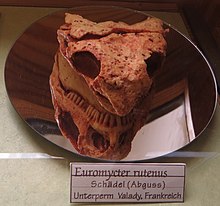| Euromycter Temporal range: Cisuralian (late Artinskian, ~
| |
|---|---|

| |
| Skull cast | |
| Scientific classification | |
| Domain: | Eukaryota |
| Kingdom: | Animalia |
| Phylum: | Chordata |
| Clade: | Synapsida |
| Clade: | †Caseasauria |
| Family: | †Caseidae |
| Genus: | †Euromycter Reisz et al., 2011 |
| Species | |
| Synonyms | |
| |
Euromycter is an extinct genus of caseid synapsids that lived in what is now Southern France during the Early Permian (late Artinskian) about 285 million years ago. The holotype and only known specimen of Euromycter (MNHN.F.MCL-2) includes the complete skull with lower jaws and hyoid apparatus, six cervical vertebrae with proatlas, anterior part of interclavicle, partial right clavicle, right posterior coracoid, distal head of right humerus, left and right radius, left and right ulna, and complete left manus. It was collected by D. Sigogneau-Russell and D. Russell in 1970 at the top of the M1 Member, Grès Rouge Group, near the village of Valady (département of Aveyron), Rodez Basin. It was first assigned to the species "Casea" rutena by Sigogneau-Russell and Russell in 1974. More recently, it was reassigned to its own genus, Euromycter, by Robert R. Reisz, Hillary C. Maddin, Jörg Fröbisch and Jocelyn Falconnet in 2011.[1] The preserved part of the skeleton suggests a size between 1,70 m (5,5 ft) and 1,80 m (5,9 ft) in length for this individual.[2]
- ^ Reisz, R.R.; Maddin, H.C.; Fröbisch, J.; Falconnet, J. (2011). "A new large caseid (Synapsida, Caseasauria) from the Permian of Rodez (France), including a reappraisal of "Casea" rutena Sigogneau-Russell & Russell, 1974". Geodiversitas. 33 (2): 227–246. doi:10.5252/g2011n2a2. S2CID 129458820.
- ^ Spindler F., Falconnet J. and Fröbisch J. (2016). Callibrachion and Datheosaurus, two historical and previously mistaken basal caseasaurian synapsids from Europe. Acta Palaeontologica Polonica 61. doi:10.4202/app.00221.2015.